Lots of European towns have goods they’re known for: cheese, pottery, port. But Coburg, during the 19th century, had the most remarkable product line of all: it turned out royals.
The monarchs of Britain, Belgium, Denmark, Norway, Sweden and Spain are all blood relations of the house of Saxe-Coburg-Gotha, as were the now-defunct or deposed nobility of Russia, Greece, Germany, Portugal, Italy, Romania, Bulgaria and Yugoslavia.
The founders of this remarkable factory were Franz Friedrich Anton (1750-1806) and his wife Auguste Caroline Sophie (1757-1831), duke and duchess of Saxe-Coburg-Saalfeld. Their little Bavarian duchy was strapped for cash when Auguste made the first trophy marriage in 1795, of her daughter Juliane to the Grand Duke Konstantin, brother of Russia’s future czar Alexander I.
Auguste’s son Leopold then married Charlotte, heir to the British throne, and the family’s fortunes really began to rise. Another of her sons, Ernst, inherited his father’s title, and through astute political and business choices, put his duchy back in the black.
The capper came in 1840 when Ernst’s son Albert married the eldest daughter of Ernst’s sister Victoire, Victoria. Victoria became Britain’s Queen Victoria, and she and Albert sired a line that would sit on the thrones of 10 European nations.
In Coburg, you can visit the founding family’s two main residences.
The Veste Coburg, a fortress atop a fist of dolomite overlooking the town, dates to the 13th century, although much of its impressive bulk was built later. Andreas, Prince of Saxe-Coburg-Gotha, the current head of the house, lived here until 1997. It has two excellent collections, both beautifully displayed. The arms and armour exhibitions show a huge selection of weapons used for hunting, fighting or pageantry through the centuries, some exquisitely worked. The armour is likewise an assortment of the plainly functional and the artistically ornate. Everything shines as if just polished and awaiting use.
Less expected, the fortress has a large art collection with important works by artists such as Albrecht Dürer and Lucas Cranach the Elder (among them his famous portrait of Martin Luther, who lived in the Veste in 1530). There’s also a marvellous assortment of glassware covering several centuries, from the Italian renaissance to 20th-century art deco.
Down the hill in town is Schloss Ehrenburg, a palace whose lavishly decorated state rooms date from the 17th to 19th centuries. The Saxe-Coburg-Gothas lived here until 1918. Top to bottom, the décor is sumptuous. The floors are intricate parquet. Richly woven tapestries hang from the walls. Chandeliers glitter. The ceilings are sinful confections of stucco work. Especially eye-grabbing is the schloss’s exuberantly baroque Riesensaal (Hall of Giants), dominated by 28 candelabra-bearing statues of Atlas, holding up the ornate ceiling.
Queen Victoria was fond of Coburg. Her beloved Albert grew up in Schloss Ehrenburg and she stayed there several times. (Her prime minister, Benjamin Disraeli, felt obliged to remind her at one point that, “you cannot run your empire from Coburg.”) Her apartments are upstairs. They include her personal throne room: a mahogany chamber containing Europe’s first flush toilet.
For more information on Coburg visit the Tourismus Coburg website at www.coburg-tourist.de. For information on travel in Germany visit the German National Tourist Office website at www.germany.travel.
More stories at www.culturelocker.com



